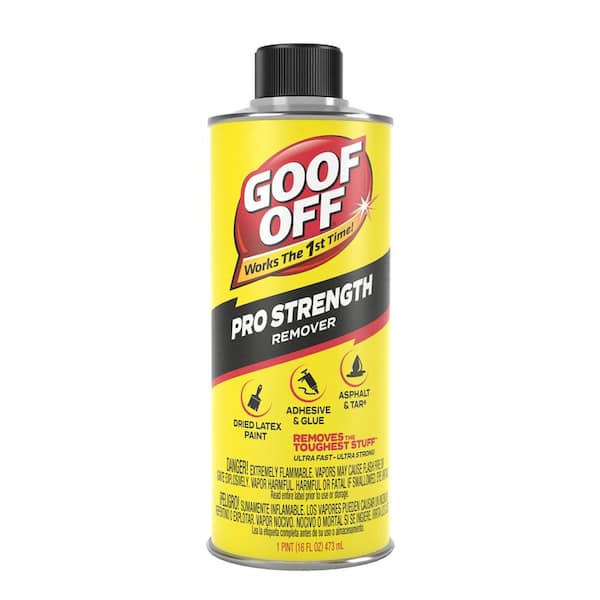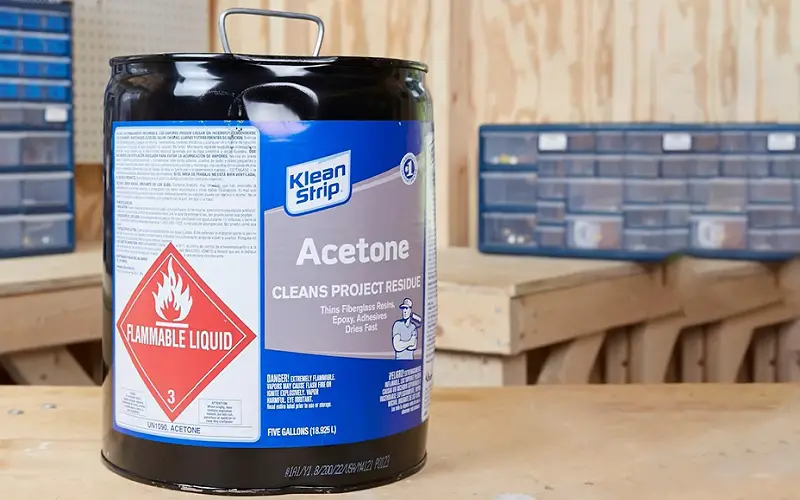Goof Off is a heavy-duty cleaner and remover, while Acetone is a strong solvent commonly used in nail polish removers and paint thinners. Goof Off and Acetone are two powerful cleaning agents that can effectively remove tough stains and substances.
Goof Off is a heavy-duty cleaner and remover that is commonly used to eliminate adhesive residue, marker stains, and grease spots. On the other hand, Acetone is a strong solvent often found in nail polish removers and paint thinners. It is particularly effective in dissolving substances like glue, paint, and varnish.
Both Goof Off and Acetone have their unique applications and can be useful in various cleaning and DIY projects. We will explore the differences between these two products and discuss their appropriate uses.
Contents
Goof off Vs Acetone
Chemical Composition
When comparing Goof off and acetone, understanding their chemical composition is essential. Both substances have different ingredients and compositions, which contribute to their varying uses and effectiveness in different applications.
Goof Off Ingredients
Goof off contains several key ingredients, including xylene, acetone, and ethanol. These components give Goof off its powerful solvent properties, making it effective for removing tough adhesives, grease, and paint stains.
Xylene provides excellent solvent power, while acetone aids in the rapid evaporation of the solution, enabling quick action in removing stubborn substances.
Acetone Composition
Acetone, also known as propanone, is a colorless, volatile liquid with a distinctive sweet odor. It is composed of molecules containing three carbon atoms, six hydrogen atoms, and one oxygen atom.
Its chemical formula is C3H6O. Acetone is a key ingredient in nail polish removers and paint thinners due to its powerful solvent properties, making it effective in dissolving substances such as varnishes, lacquers, and adhesives.
Uses
When it comes to household tasks and DIY projects, having the right solvents on hand can make a world of difference.
Two commonly used solvents are Goof off and acetone, each with their own set of uses and applications. Let’s take a closer look at the different ways these solvents can be utilized in various situations.
Applications Of Goof Off
Goof off is a multipurpose solvent that can be effectively used for a variety of tasks. Its versatility makes it a valuable tool for homeowners, craftsmen, and professionals alike.
- Cleaning adhesive residues, such as stickers, labels, and tape
- Removing paint and graffiti from surfaces
- Getting rid of tough stains and spills, including ink, marker, and crayon
- Breaking down and cleaning up tough, greasy messes
- Stripping away old varnishes and finishes from wooden items
Common Uses Of Acetone
Acetone is widely known for its versatility and effectiveness in various applications. It is a commonly used solvent that finds its place in various industries as well as households for its diverse range of uses.
- Thinning and cleaning fiberglass resins and epoxies in the construction industry
- Removing nail polish and acrylic nails in the beauty industry
- De-greasing and cleaning metal surfaces in mechanical and automotive applications
- Reducing and dissolving various adhesives, including super glue and epoxy
- As a solvent in the production of pharmaceuticals, plastics, and synthetic fibers
Safety Precautions
Handling of Goof off
When handling Goof off, always wear protective gloves to prevent skin irritation.
Store Goof off in a well-ventilated area away from heat sources and open flames.
- Ensure proper labeling of Goof off containers to avoid confusion.
- Avoid prolonged exposure to Goof off fumes by working in a well-ventilated area.
Safety Measures For Acetone
Handling of Acetone
Always wear safety goggles and gloves when using acetone to prevent eye and skin irritation.
Keep acetone away from heat sources as it is highly flammable.
- Avoid inhaling acetone fumes by working in a well-ventilated area.
- Do not mix acetone with other chemicals as it may produce hazardous reactions.

Environmental Impact
When it comes to choosing the right product for removing tough stains and adhesives, Goof Off and Acetone are two popular options.
However, it’s vital to consider their impact on the environment. Let’s delve into the eco-friendliness of Goof Off and the environmental concerns associated with Acetone.
Eco-friendliness Of Goof Off
Goof Off is known for its environmentally friendly formula, making it a preferred choice for individuals who prioritize sustainability.
This multipurpose remover is biodegradable, meaning it will break down naturally over time, thus minimizing its impact on the environment.
Moreover, Goof Off is non-toxic, ensuring the safety of both users and the ecosystem. Its low VOC (volatile organic compound) content helps prevent air pollution and reduces the risk of harmful environmental effects.
The packaging of Goof Off is also worth mentioning. The company makes efforts to use recyclable materials, further reducing waste and promoting a greener approach to cleaning.
Acetone’s Environmental Concerns
On the other hand, Acetone raises some environmental concerns due to its chemical composition. While it is effective at removing difficult substances, its impact on the planet cannot be ignored.
When Acetone is released into the environment, whether through improper disposal or during use, it can contribute to air pollution. The emission of volatile organic compounds from Acetone can lead to the formation of ground-level ozone, which is harmful to human health and can deteriorate air quality.
Additionally, Acetone is not biodegradable, which means that once it enters the environment, it persists for a significant period, potentially causing long-term harm to ecosystems.
It is important to handle and dispose of Acetone responsibly to mitigate its adverse effects. Proper ventilation and adherence to safety guidelines are crucial to minimize its impact on both human health and the environment.
Effectiveness
The effectiveness of a cleaning solvent is crucial when tackling tough stains and sticky residues. Two popular options in this realm are Goof off and Acetone. Understanding their effectiveness can help you make an informed decision on which one to use for your cleaning needs.
Performance Of Goof Off
Goof off has gained a reputation for its exceptional performance in removing various types of stains and substances.
It is particularly known for its ability to dissolve adhesive residues, grease, crayon marks, and other stubborn substances that can be challenging to remove using conventional cleaning products.
One of the reasons behind Goof off’s impressive performance is its powerful formula, which contains a blend of strong solvents and surfactants.
This combination allows it to penetrate deep into the affected surface, breaking down the bonds holding the stains or residues in place.
| Pros | Cons |
|---|---|
|
|
Efficiency Of Acetone
Acetone, on the other hand, is a widely used solvent known for its high efficiency in dissolving tough substances.
It is commonly used for removing nail polish, but its cleaning abilities go beyond that. Acetone is highly effective in breaking down glues, resins, and paint residues, making it a valuable tool in various industries.
As a powerful solvent, Acetone acts rapidly, allowing for efficient and time-saving cleaning processes. Its ability to cut through stubborn substances is attributed to its strong bonding properties, which enable it to disintegrate even the toughest stains or residues.
| Pros | Cons |
|---|---|
|
|
Cost Comparison
Comparing the cost of Goof off and acetone can help determine the most cost-effective solution for your needs.
- Goof off is generally more budget-friendly compared to acetone.
- Affordable and effective, Goof off is a popular choice for DIY enthusiasts.
- Acetone might be more expensive than Goof off in certain cases.
- Its cost-effectiveness depends on the quantity and purpose of use.

Frequently Asked Questions For Goof Off Vs Acetone
Is Goof Off Like Acetone?
No, Goof Off is not exactly like acetone. It contains xylene and ethylbenzene. Acetone is a pure solvent, while Goof Off is a mixture of solvents and other ingredients.
What Is Better Goof Off Or Goo Gone?
Goo Gone is better for removing sticky residues, while Goof Off is better for tough stains and paint. They have different uses.
What Solvent Is In Goof Off?
Goof Off contains various solvents to remove tough stains and sticky residue.
Does Goof Off Melt Plastic?
Goof Off can melt plastic as it contains strong solvents that may damage plastic surfaces.
Conclusion
Overall, both Goof off and Acetone have their distinct advantages for removing stubborn stains.
Depending on the surface and type of stain, the choice between the two can make a big difference.
Remember to test on a small area first before tackling the main task.

